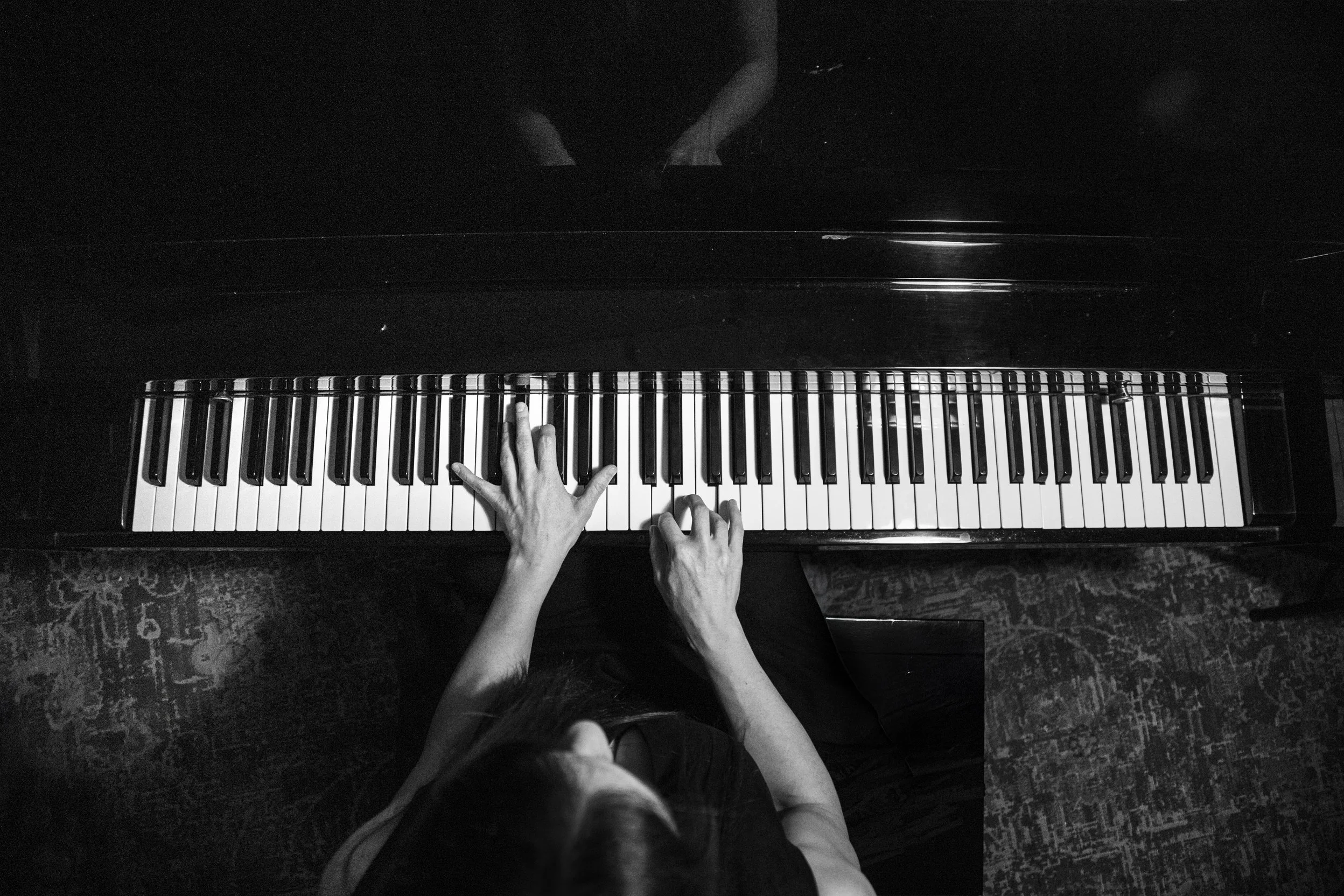
Liner Notes by James Kaplan
Discover the story behind the music in beautifully written liner notes by James Kaplan, acclaimed author and music critic. His reflections bring fresh insight and context to Maria’s debut album—inviting you to listen with new ears.
Taking the Foreground
by James Kaplan
“I was hearing some beautiful piano”
A few months ago, after giving a reading at an elegant Upper East Side social club, I sat at the nice dinner my hosts had thoughtfully provided, chatting with my interesting tablemates and half-hearing the pleasant background music played by a young pianist across the room. As I sat and ate and talked, though, I soon realized I was only listening to the conversation with one ear: with the other I was hearing some beautiful piano. The playing was soulful — melancholy and thoughtful at times, at times bright and cheerful, even mischievous. Along with American Songbook standards there were what sounded like original tunes — all of it, whatever my hosts’ intentions, simply refusing to stay in the background.
“how much I’d enjoyed the music”
The young woman at the piano looked serious, though I thought I caught her quickly smiling to herself now and then over the keys, perhaps with pleasure at the beauty she was creating. At the end of the evening I shook her hand and told her how much I’d enjoyed the music. She smiled shyly and thanked me; her name, she said, was Maria Kaushansky. A few weeks later I was pleasantly surprised to get an email from her through my website, asking if I might be interested in writing the liner notes for her first album, Northbound to Finch. The album, she said, was to consist entirely of her own compositions. Of course I would want to hear it before deciding, she wrote. Of course.
“The music arrived in my inbox: I listened and listened again.”
The album is in trio format, Maria’s two accompanists, bassist Paul Gill and (sadly, now the late) drummer Anthony Pinciotti, showing a palpable love for Maria’s playing, and her compositions. They support and inspire her, but never obtrude into this remarkable sequence of songs.
Northbound to Finch is a musical memoir, inspired by Kaushansky’s childhood and young womanhood in Toronto, where her family moved after emigrating from Russia and Israel in the early 1990s. The songs — by turns meditative, urgent, and sprightly — are infused with a quality the Brazilians call saudade: nostalgia for a past that can be summoned wistfully but never entirely recovered. But this is the northern variant of that quality — one can feel in the music the dimming sunlight as the Canadian winter comes on, the first icy showers of snow in a gray, quickening wind.
The tunes also reflect the evolution of an artistic sensibility, glittering here and there with hints of pianistic influences such as Brad Mehldau, Joni Mitchell, and Chick Corea. But the album’s dominant voice, rich, evocative, and tonally adventurous, is Maria Kaushansky’s own.
1) Northbound to Finch:
The lovely title number roams but with purpose, gathering urgency then pausing for reverie, like scudding clouds over a vacant lot.
2) Windchill -30:
“Windchill -30” begins with a bass meditation that segues into a brisk Middle Eastern drive, pausing to take in the whimsy of an icy gust, before the Middle Eastern theme continues, interrupted by sweeps, quirks, and flukes of wind.
3) So Long Centerpoint Mall:
“ So Long Centerpoint Mall” is a farewell to youth, an aching wish to go home mixed with the knowledge of the impossibility of returning, melancholy brightened with the possibility of joy: gray clouds pierced here and there, now and then, with darts of sun. Maria says, “There has been so much development in Toronto in recent years that some neighborhoods are hardly recognizable to me anymore. Learning of the possibility of Centerpoint Mall being demolished felt quite sad, as it holds so many of my childhood memories.”
4) Last Call at the Green Room:
Last Call at the Green Room summons the memory of a dive bar that Kaushansky used to frequent with friends when they were students at the University of Toronto. “The driving energy of the tune,” she says, “evokes not only fun nights out, but also the rush to catch the last train home, around 2 a.m.”
5) Tangreen Court:
This stately tune reflects a child’s awe at new surroundings interspersed with bittersweet, McCartney-like retrospect: fear, hope, wonder. “Tangreen Court,” Maria says, “is the name of the street where my family first lived when we immigrated to Toronto. It was our first home in a country that was new to me; I was only ten years old. We arrived in February, deep in the middle of winter. Thoughts of Tangreen Court evoke so many new experiences — country, culture, languages (not just English, but also French); school, friends, and climate.”
6) 512 St. Clair:
Urgency returns in a song that begins with drumbeats like footsteps, followed by pulsing chords that evoke the passionate solemnity of dancers beginning a class. “When I was still a university student at the U of T,” Kaushansky recalls, “I began working as an accompanist in a local ballet school, the Ontario School of Ballet (OSB). ‘512 St Clair’ is the name of the streetcar I used to take to get to OSB. Playing for ballet dancers became a significant part of my life, and still is to this day.”
7) Prelude:
This brief, evocative piece, rich with colors of the North, traces a gamut of inspirations, from Scriabin to Joni.
8) Newtonbrook:
Newtonbrook is the name of the public high school which Maria attended from grades 9 to 12. The tune begins with, and returns again and again to, a sweet folk melody evoking the grace and awkwardness of youth, and the joy and pain of discovery.
9) Four One Six:
The title refers to the area code for Toronto; the piece is a sweet outlier on the album: a bouncy, infectious, hard-boppy riff — a reminder that Canada, for all its staid reputation, has soul. To borrow Miles’s highest term of approbation, “Four One Six” swings.

“Northbound to Finch, the album, is a work of nostalgia and farewell, but it’s also one of greeting, announcing the arrival of a bright new talent, moving here and now from the background to the foreground.”
—— James Kaplan, author, 3 Shades of Blue: Miles Davis, John Coltrane, Bill Evans, and the Lost Empire of Cool



